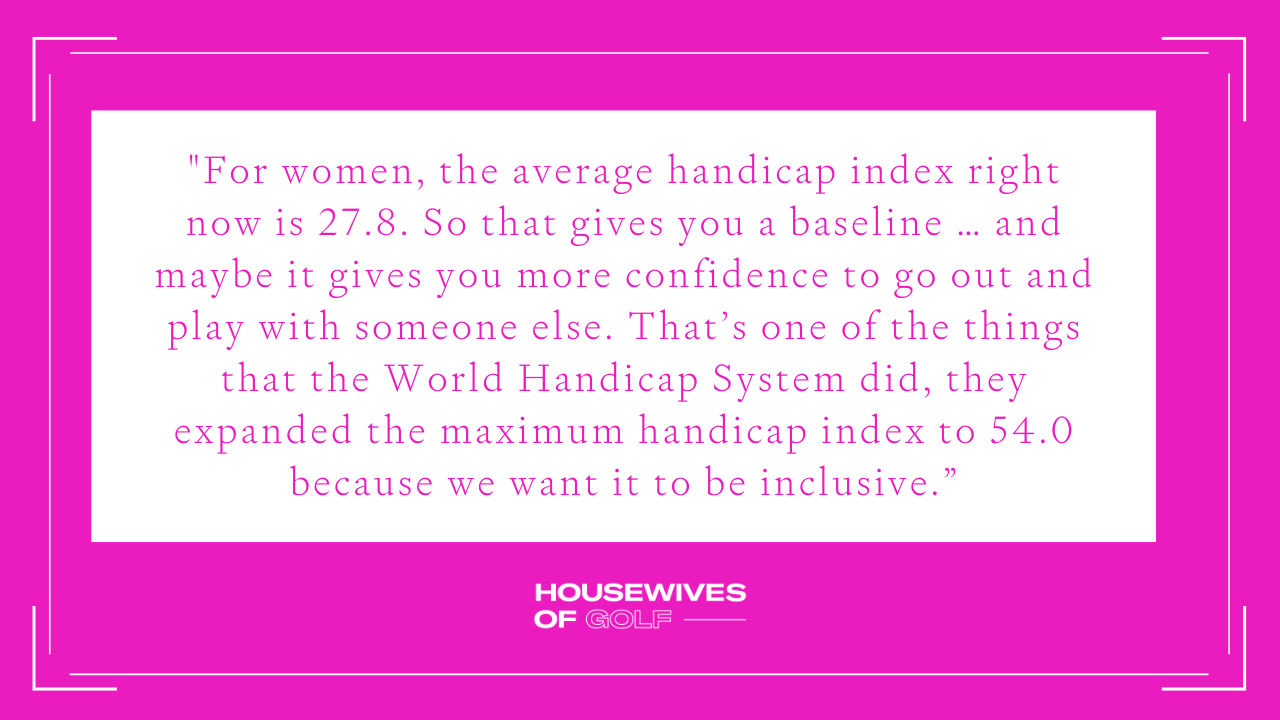
Understanding the Handicap Index: A Primer for Beginner Golfers
Golf is a sport that can range from a fun, relaxing afternoon with friends to an intense, highly skilled competition—with everything else in between. And that’s what we love about it! There’s tons of room to learn, grow, and develop your golf game and take it to the next level. One thing to help get you there? Understanding and establishing a Handicap Index.
Now, before you click away from this article because it seems overwhelming, give it a chance. The Handicap Index doesn’t require math (there’s an app for that!), a certain level of skill, or any other requirement to get started. It’s a tool that helps you track your progress, expand your game, and explore new golfing experiences.
To break things down, we invited Frances Nee from the USGA (United States Golf Association) onto the Housewives of Golf podcast. Fran oversees administration of the handicapping and course rating department in the USGA and gave us the 411 on what we need to know. And, well, we might have also talked about our mutual love for the Housewives franchise!
So, for all our beginner golfers, here’s everything you need to know about the golf Handicap Index.
The Handicap Index Basics
Let’s start out with the basics. In Fran’s words, a Handicap Index is a “measurement of a player’s demonstrated ability.” It represents your potential scoring ability based on how many strokes it would take to adjust your score to par. A high handicap means that it will take you more strokes to finish the course, indicating a golfer with lower skill level.
Once golfers begin tracking their scores, it’s compiled into a Handicap Index that changes with every new game played. It’s calculated by counting all strokes on the course and then calculating a score differential according to the course and tee ratings. Out of 20 scores, the lowest eight will be averaged for your USGA Handicap Index. And since the index represents an average of your eight lowest scores, you can expect to score to your Handicap Index around 20% of the time.
This system of using a Handicap Index has been around for over 100 years. Recently, though, golf associations around the world have developed a world handicap system to standardize things internationally.
The main purpose of the Handicap Index system is for golfers of all levels to play with each other—it levels the playing field. Another benefit is that it helps golfers track their progress as they improve and grow in skill level.
Why Beginner Golfers Need a Handicap Index Rating?
If you’re a beginner golfer or have been golfing for a short time, you’re probably thinking—this isn’t for me! There are common misconceptions that you should be super consistent or scoring low numbers before getting a Handicap Index rating. You might even think it’s just for people who want to compete or take part in tournaments.
But the reality is, a Handicap Index rating is for all golfers! There are multiple reasons why you should consider getting yours:
- It establishes a baseline skill level so you can see your improvement over time.
- Gives you the option to play at tournaments or events that require a handicap index.
- Allows you to play with golfers at different skill levels on a level playing field.
- Helps you explore and enjoy other golf courses, including participating in events and tournaments they host.
Beginner golfers might feel embarrassed by a high score or to start tracking their progress. But it’s important to remember that we all start somewhere! When you start tracking your progress, you’ll be motivated to practice and continue developing your skill. And even if you plan to golf just for fun, it opens new opportunities to golf with other people and in other places.
Simply put, establishing your Handicap Index opens opportunities in golf. All golfers should take advantage of this tool and get one today.

How to Get a USGA Handicap Index Rating as a Beginner Golfer
Okay, so what are the practical steps you need to take to get your handicap index? It starts with forgetting about those arbitrary markers of being “ready” for one—if you golf, you’re ready.
To start, you need to sign up with a Golf Association (GA) of Golf Club. This can be intimidating to some people, but the USGA has made it easy. They’ve compiled all GAs into an online database, searchable by zip code. When you sign up at www.usga.org/getahandicap, you’re automatically assigned to and enrolled in a GA according to your zip code.
From there, here’s what you need to do to establish your USGA handicap:
- Golf 54 holes in any combination of 9 or 18-rounds; this can be at the same or different golf courses.
- Track your scores in an app or calculator (or do it manually if you love math!). To keep it simple, you can enter your score and where you’re playing and the app will automatically calculate your handicap index based on the course, the tees, and your score.
- Get your initial handicap score and take some time to understand it, perhaps comparing to other people in your demographic.
- Continue to track every new round to keep it up to date. Make sure you’re tracking everything—not just your good rounds! Your handicap index is only a useful tool for improvement if you are keeping it accurate to how you’ve played.
Being part of a club helps uphold handicapping rules and regulations while investigating any false data. It also acts as a resource hub for you to ask questions, get some golf tips, and learn more about the Handicap Index and other golf technical skills and rules.
Once you’re part of a GA, you can take advantage of their many perks, benefits, and events. We love events like “nine and wine,” where you can play nine holes with some friends, grab a drink, and get to know more people in the golfing community.

Technicalities: Slope, Rating, and Maximum Scores
At first, the handicap index can seem complex. But it’s one of those things that makes more and more sense as you keep going. So, don’t let this technical section scare you off!
There are a few important concepts to understand that are tied to the Handicap Index. These are some things to tuck away for the future that you can investigate further and learn more about as your skill and experience in golf grows.
- Maximum scores: This refers to the highest score you can have for a hole to help keep the game moving and not keep people held up. They are in place to account for blow up holes and help prevent severe handicap index fluctuation. With no established USGA handicap, your maximum score is par plus five; with a handicap index, it’s a net double bogey.
- Course rating: Every tee box is rated to account for what a typical scratch golfer would shoot with that rate of tees. So, if it’s rated as a 71, a scratch golfer should score 71. The USGA is currently pushing to have all tees up to 6000 yards to be rated for both men and women.
- Slope rating: This ranges for 55-155 and accounts for the difficulty for a bogey golfer. The higher the number, the harder the course.
Courses need to be rated every ten years or after any course upgrades or maintenance. These numbers can help golfers understand the course they’re playing and predict what score they might be able to achieve.
Like the Handicap Index itself, these technical concepts are in place to make golf a more inclusive sport for everyone. No matter your skill level, golf is for you! And by understanding your USGA handicap rating and how it interacts with other technical golf components, you can continue to grow in skill and experience.
Conclusion
No matter if you’re a beginner just looking to play golf for fun or are serious about upgrading your skills—the Handicap Index is your logical next step. There’s no pre-requisite to establish one and it’s a tool that will help establish a baseline skill level to work from. More than that, it will open new opportunities for you in golf; you can play with anyone and check out new courses or participate in fun tournaments and events.
While the Handicap Index is technical, it doesn’t have to be complex. We’re so glad Frances Nee was able to join us to break down how the USGA handicap works. If you want to get started with establishing your Handicap Index, visit the USGA’s website: www.usga/getahandicap. The USGA has recently launched their location-based database of Golf Associations, making it easier than ever to get connected and start establishing our Handicap Index.
And, if you want to hear the entire interview with Fran, check out her interview on the Housewives of Golf podcast! We talk all-things golf and golf tips for women and beginner golfers to the sport. And, we have a lot of fun. See you on the green!

Podcast Time Stamps
5:45 - Frances journey to USGA
9:34 - What is a Handicap Index?
10:19 - Importance of Handicap index for new golfer
13:57 - Is it complicated to calculate index?
15:12 - Why do you need Handicap Index even if you are not playing tournament?
17:32 - Sarah’s first tournament experience
20:25 - What’s the first step
23:40 - Benefits of joining association
34:22 - What is soft cap?
38:18 - Everything about slope and ratings
48:08 - Talking about housewives
Resources
Connect with us on your favorite social platform:
Subscribe to our FREE Female Golfer Facebook Group: Housewives of Golf
Tori:
Instagram: @tori_totlis
TikTok: @tori_totlis
Website: CompeteConfidenceGolf.com
Sarah:
Instagram: @sarahheldgolftravel
Website: EliteGolfExperience.com
Podcast IG: @housewivesofgolf
Podcast YouTube: Housewives of Golf
Be sure you are subscribed to our podcast to automatically receive the NEW episodes weekly!!!




